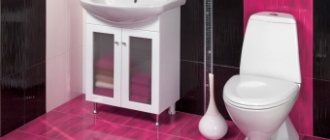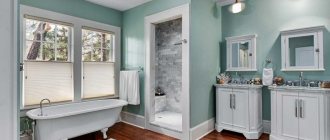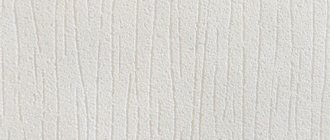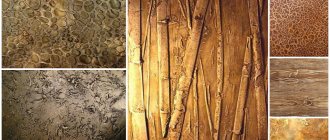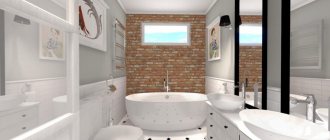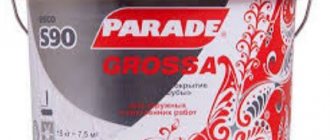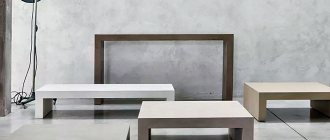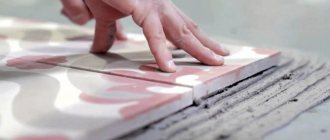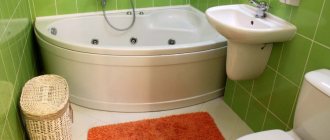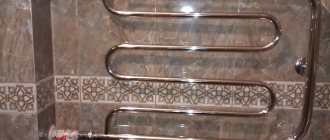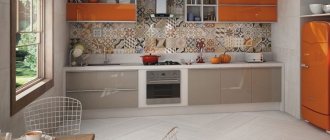Before you think about finishing a bathtub, you need to understand what features this room has that can affect its finishing. Most people have tiles in their bathrooms, which is considered the norm, and other options are not considered. The reason for this phenomenon is obvious - very high humidity, and other finishing materials do not last long in such an environment. Due to high moisture, droplets of water regularly appear on the surface of the walls in the bathroom, making the entire wall wet.
Is it possible to use decorative plaster in the bathroom?
It is quite possible to decorate the walls in the bathroom with a decorative composition. Moreover, such a finishing material serves as an alternative to tiles. Moisture-resistant decorative plaster is suitable for the bathroom; it looks beautiful and can maintain a healthy microclimate in a room with excess humidity. The point of view that such a mixture is not suitable as a finishing material in the bathroom is erroneous. If the application technology is followed, such a coating will last no less than tiles.
As an alternative to tiles in the bathroom, you can use decorative plaster
Is it possible to do?
Thanks to the acrylic base, decorative plaster has become impervious to moisture. The material is not afraid of temperature changes. Decorative plaster does not require special care. Antistatic treatment prevents the adhesion of dirt and dust.
The manufacturer produces finishing materials that allow you to create a realistic imitation of stone or wood. Unlike tiles, plaster has high vapor permeability. This allows you to maintain a comfortable microclimate in the bathroom.
Peculiarities
An acrylic or silicone base is used as a binder, which allows the filler fibers to be connected to each other. In this case, a monolithic layer is formed, which has great strength. The quality of decorative plaster depends on the type of filler , which can be natural or artificial.
In this case, you need to take into account the shape, size and color of the grains. Using modified additives, manufacturers increase the elasticity and fire resistance of the material. In conditions of high humidity, mold can form on the surface of the walls. To prevent the growth of fungi, special additives are used.
Types and photos
Depending on the composition, there are several types of plaster; they can be seen in the photo.
- Mineral products have sufficient strength and wear resistance. Condensation does not accumulate on the walls, since the material has sufficient vapor permeability. Mineral plaster contains cement and lime. Its disadvantage lies in its low ductility.
- In the production of acrylic plaster, small fractions of marble and glass are used. Synthetic resins are used as a binding component.
- Silicone plaster is easily applied to the surface of a concrete base. The material does not fade under the influence of ultraviolet radiation. Silicone resins provide good air exchange and protect against moisture.
Attention
On sale you can find silicate plaster that contains liquid glass. The finishing material does not allow water to pass through and prevents the formation of mold. The characteristics of materials depend on the type and filler and structure.
Venetian
Multilayer coating allows you to visually enlarge the room. Venetian plaster has water-repellent properties. Natural ingredients are used in the production of the mixture.
To avoid cracks, polymer additives are added to the plaster. Buyers appreciate the material for its shine, which emphasizes the luxurious appearance of the bathroom.
The material can withstand significant temperature changes.
The disadvantage of Venetian plaster is the high labor intensity of finishing . The material is made on the basis of slaked lime. Microcalcite, acrylic and polymer additives are added to the mixture. The presence of ground marble in the composition creates an imitation of natural stone. The finishing material is most suitable for rooms with a small area.
Structural
The material used to make structural plaster has a granular structure. Acrylic or silicate is added to the composition as a base. When hardened, the finishing material forms a durable layer that is sufficiently waterproof.
Textured
Textured plaster has a viscous structure. Marble or granite chips are used as filler. The material contains mica and wood. Long fibers make it possible to hide large defects on the surface of the walls.
Important
To apply the composition you do not need to have high qualifications.
There are several types of textured plaster:
- To create a finishing material in the “lamb” style, pebbles are added to the composition.
- “Shuba” is distinguished by a rough surface, which gives a unique look to the bathroom.
- If desired, you can create an imitation of a wooden wall eaten away by pests (“Bark beetle”). To do this, uneven grooves are created along all surfaces.
What color scheme should I choose for the walls?
There are a large number of color options. When choosing the shade of finishing material, you need to take into account the style in which the apartment is decorated. Preference should be given to the following colors :
- white;
- grey;
- blue;
- gold;
- green;
- beige.
Thanks to tinted plaster, you can give the room a luxurious look. If you plan to repaint the walls in the future, it is better to choose light colors. For example, a light blue shade can easily be changed to purple or burgundy. To create a voluminous texture, you can use a roller.
Advice
For additional protection from moisture, the coating is treated with wax.
Features of DIY technology
First you need to evaluate the geometry of the walls. Before applying finishing materials, defective areas must be identified. To level the walls, beacons made of metal or plastic are used. The distance between the planks should be about 150 cm. In this way, you can determine the level to which you need to focus when laying the plaster.
What tools are needed?
To perform finishing work you must purchase:
- Master OK;
- putty knife;
- rule;
- grater;
- mixer;
- perforator;
- chisel.
Preparation and application of plaster mixture
First you need to clean the wall down to the concrete base. Plaster will not adhere to whitewash or oil paint. The surface of the brickwork should be cleaned using a wire brush. Protrusions that are present on the concrete base must be removed. You can use a chisel for this. Large cracks must be filled with mortar.
In new buildings, concrete walls may have a too smooth surface. To improve the adhesion of the solution to the surface, it is necessary to apply notches. A hammer drill can be used for this purpose. The depth of such notches should be about 2-3 mm. In brickwork, you can simply deepen the seams by 8-10 mm.
To seal through holes, it is recommended to use a thick cement mixture. In places where communications exit, you need to remove the old solution. After this, get rid of construction waste. The holes should be free of dust and dirt .
You can remove oil stains and bitumen by using caustic soda. After drying, the treated surfaces should be washed with water. The quality of the finish depends on the defects that are present on the walls of the bathroom.
Attention
The owner must get rid of traces of mold and rust. To eliminate large defects, cement mortar will be required. To increase strength, brick chips are added to its composition.
Before applying the finishing material, it is necessary to protect the communication terminals. You can use masking tape for this purpose. To eliminate unevenness on the base, it is necessary to apply a layer of primer. After installing the beacons, you can begin applying the plaster solution. The next step is to grout and dry the surfaces.
There are several conditions that must be met when applying plaster:
- When carrying out finishing work, the humidity in the bathroom should not exceed 60%.
- The optimal temperature for applying the solution can range from +5 to +35 degrees.
- All wiring must be disconnected.
There are several techniques that allow you to apply the composition to the base.:
- To make the “spray” you can use a ladle or trowel.
- To “spread” you will need a spatula or trowel.
- During the finishing process, workers resort to “cutting”. Thanks to the “pecking” movements of the brush, you can get a unique relief.
- The most common technique is “roller rolling”. In this way you can quickly apply the solution to the walls.
Relief can be formed in several ways:
- The specialist rolls the print using a shaped roller or stamp.
- The furrows are applied with a stiff brush or spatula.
- Workers can use stencils.
Tools for applying decorative plaster must be selected taking into account its structure. To use a coarse mixture, you need to purchase a roller, brush and spatula. It is most convenient to apply a finely dispersed solution using a sprayer.
Mold stains must be removed and wiped with a disinfectant solution.
Pros and cons of decorative plaster in the bathroom
Textured plaster has been used relatively recently for bathroom decoration. This is explained by the fact that modern finishing materials have better performance characteristics compared to building materials produced in the recent past.
Advantages of decorative plaster
Waterproof decorative mixture has a lot of advantages:
- Plastic panels and tiles do not allow the walls to “breathe”, and all types of plaster, with the exception of acrylic, are vapor permeable. That is why moisture does not accumulate on the surface of plastered walls, which means that the cladding remains clean for a long time.
- After hardening, the composition becomes very durable and lasts for decades.
- Practical, easy to clean, environmentally friendly.
- With its help, you can create a unique bathroom interior design with your own hands, while simultaneously eliminating wall surface defects.
- Excellent adhesion to any base - concrete, gas blocks, brick.
- The plastered wall is warm to the touch, which distinguishes the material from tiles and plastic panels. Thanks to plaster, a comfortable microclimate for bathing is created in the bathroom.
- The material does not burn, so it can come into contact with heating devices.
One of the advantages of plaster is its long service life.
Disadvantages of decorative finishing
Like any other finishing material, decorative plaster in a bathroom or toilet has disadvantages:
- A beautiful, high-quality mixture for plastering walls with intense pigments in its composition and a pronounced texture is not cheap.
- Finishing with a mixture requires certain skills; an inexperienced beginner rarely manages to create a masterpiece with his own hands.
- It is extremely difficult to remove a hardened moisture-resistant coating from a wall, so it should be selected as carefully as possible.
Important. It is not recommended to cover all the walls in the bathroom with plaster. Areas adjacent to a bathtub or shower are best tiled with tiles or porcelain tiles.
Considerable price is one of the disadvantages of this material.
What type of bathroom decorations can you choose?
Plaster in the bathroom is often exposed to aggressive influences. In a room where the temperature and humidity levels change, only waterproof finishes are used.
When choosing a coating, you should consider the following nuances:
- Plaster mixtures are produced ready-to-use and dry; they are convenient to work with because they are easy to dilute to the required consistency.
- Applying a composition with large-sized decorative elements requires experience in wall cladding or the involvement of a professional.
- Water-based decorative coating is not suitable for the bathroom. The plastered surface will not be able to resist external damage without waxing, and when applying varnish, vapor permeability will disappear.
Decorating a bathroom with decorative plaster depends on the personal preferences of the owner.
Flock, stone and mosaic compositions are not suitable for wall decoration. It is also better to refrain from covering bark beetles, because the grooves create conditions for mold to appear.
Textured, thin-layer and structural coatings that do not reduce space and are easy to clean correspond to a humid microclimate.
Textured
This type of plaster is suitable for rooms with an unfavorable microclimate: high humidity and changes in temperature. The cladding is resistant to aggressive elements and mechanical stress.
It is a multicomponent composition that contains:
- natural fibers;
- stone particles;
- mineral chips.
The fillers included in plaster help create different textures. A relief surface is obtained after applying the composition.
Venetian
This mixture is distinguished by its decorative and performance qualities. The composition includes slaked lime, the base is supplemented with acrylic resins, pigments and mineral particles. Marble inclusions in the material provide an imitation of natural stone. Microcalcite in the plaster is replaced with quartz or granite dust.
Venetian cladding looks impressive on walls, visually expands the space of bathrooms and gives additional depth. Imitations of light yellow onyx look warm. After drying, it is recommended to cover the multi-layer coating with wax.
Structural
This plaster should not create a strong volume indoors. The “wet silk” coating, which is applied in a thin layer, looks interesting. Imitation of patina on travertine masonry will suit the design of a spacious bathroom with copper fixtures and antique furniture.
Sanitizing
The composition creates a waterproofing layer and prevents the release of sulfate and other salts. This quality distinguishes the mixture from other cement-sand based plasters.
The protective effect manifests itself as follows:
- moisture from the load-bearing wall is directed to the porous layer, in which sulfate salts are retained;
- the liquid is removed through micropores of the second composition;
- The last layer of plaster dries and creates a film that limits the penetration of moisture into the room.
This type of cladding levels the surface and forms a decorative coating. Suitable for bathrooms and toilets. The plaster consists of several components: first a layer of base primer is applied, the next is a sanitizing layer, on top of which the finishing composition is applied. The room can be decorated in any style and color. There is no need to coat the walls with varnishes or additional mixtures.
Facade
This type of plaster is rarely used when renovating a bathroom. The rough structure of the coating is only suitable for some interior styles. The compositions are used for the design of external facades, and not internal ceilings.
The advantages of the mixture include:
- high strength - the decorative finish will not be damaged as a result of mechanical stress;
- long service life of the material - will allow you to maintain the finish until a new renovation;
- Possibility of use outdoors - moisture-resistant plaster can easily withstand the effects of steam, drops of water and elevated temperatures.
Plaster
The main binder in this plaster does not tolerate use in humid microclimates. This is a possible, but not the best option for finishing work in the bathroom. The environmentally friendly material is used to decorate interior walls that require leveling. The solution is applied without prior puttying in a thick layer. The presence of special additives in gypsum plaster ensures adhesion to any substrate. It is recommended to use it as a starting coating, on top of which a decorative layer is applied.
Cement
Plaster based on this material creates a strong, durable layer that is insensitive to high humidity, temperature changes, and mechanical stress. A composition that contains binders and antiseptic additives is suitable for bathrooms.
Moroccan plaster in the bathroom
This type of plaster is rarely used for wall cladding in bathrooms. In the East, where the coating appeared, the mixture was used for interior decoration of palaces. The coating was applied to surfaces that were often in contact with water. The plaster is suitable for finishing cladding of sanitary rooms. The classic application technique is labor-intensive and expensive, but the luxurious and unusual design is worth the investment.
Types of decorative plaster by type of base
Modern plaster, intended for rooms with high humidity, is divided into several types:
- Mineral. Inexpensive, durable, vapor-permeable, but has low ductility and needs to be painted, as it looks ugly on the wall by itself.
- Acrylic (polymer). Does not require dilution with water, is resistant to deformation, durable after hardening. The main component of the composition is acrylic.
- Silicone. It is relatively expensive, but has average vapor permeability, excellent quality and performance characteristics. It is plastic, dust does not settle on it, since thanks to the silicone present in the composition, the electrostaticity of the coating is zero.
- Silicate. It has good elasticity, vapor permeability and adhesion to various types of substrates. Resistant to temperature, high humidity and mechanical damage.
Types of decorative plaster
Silicone plaster
The mixture contains silicone resins, thanks to which the renovation made in the bathroom will have its original appearance for 60 years, or even longer. Silicone plaster is very easy to clean, insensitive to ultraviolet rays, and can repel water from the surface. Mold or mildew will never appear on it.
The binder of the mixture is represented by emulsified silicone resins. Drying of the composition is accompanied by polymerization with the simultaneous formation of an elastic, durable film that can hold even particles of stones.
The silicone mixture does not allow the walls to become damp, since its components have water-repellent properties.
Advantages of silicone plaster:
- adheres perfectly to any base (except for metal surfaces);
- resistant to aggressive chemical compounds;
- does not change properties under the influence of high temperature;
- does not accumulate static electricity - dust does not accumulate on its surface;
- durable - even when the building shrinks, a wall covered with silicone plaster will not crack.
The disadvantage is the high cost of the mixture.
There are 3 modifications of silicone plaster:
- Acrylic silicone.
- Silicate-silicone.
- Siloxane.
Silicone decorative plaster
Mineral plaster
This mixture consists mainly of cement, lime and an additive in the form of marble chips, which provides the texture of the coating. The larger the size of the marble chips, the more prominent the plastered surface is. Almost all mineral mixtures are available in light shades - mainly white or gray.
Waterproof mineral plaster, which can be used for wall cladding in the bathroom, contains water-resistant additives. Thanks to them, the care of the plastered surface is simplified - it is easy to wash off dirt from it. Vapor permeability ensures the “breathing” of the walls. After hardening, the composition becomes very durable and resistant to mechanical damage. The hardened mineral-based mixture does not tolerate vibrations and is slightly elastic.
Advantages:
- wide range of mineral compositions;
- durable;
- inexpensive;
- It’s easy to work with even for a beginner.
Mineral mixtures include cement, lime, clay and gypsum mixtures. Clay and lime ones are not suitable for the bathroom; gypsum or cement are suitable.
Modifications of mineral plaster are as follows:
- Cement-polymer.
- Cement-lime.
Mineral decorative plaster
Polymer plaster
Polymer, or acrylic, plaster is an initially usable water-based composition. Contains marble chips, small pieces of glass, synthetic resins. Easily tinted.
Advantages:
- resistant to moisture;
- has a long service life - a wall coated with polymer will remain in its original form for up to 50 years.
Flaws:
- does not allow steam to pass through, for this reason it cannot be used in a room with poor ventilation.
Polymer decorative plaster
Silicate decorative plaster
Silicate finishing material consists mainly of potassium glass. The surface covered with silicate plaster repels water, so fungus or mold will never appear on it. Excellent steam permeability. More than 250 shades of silicate decorative mixtures are produced.
Advantages:
- hardens quickly;
- resistant to aggressive chemical compounds;
- easy to clean;
- durable.
Flaws:
- before applying the mixture, it is necessary to coat the surface of the base with a silicone primer;
- must be painted with silicate paint;
- Expensive.
Silicate decorative plaster is produced in the form of a dry mixture or paste, packaged in buckets.
Silicate decorative plaster
Silk plaster
Another option is to decorate the walls with silk plaster. Otherwise it is called “liquid wallpaper”. It is an inexpensive, easy-to-use finishing material consisting of cellulose or silk fibers, pigments, and glue. Moisture-resistant silk plaster is great for the bathroom.
Advantages:
- environmentally friendly;
- durable after hardening;
- resistant to temperature changes;
- immune to ultraviolet rays;
- the damaged surface is easy to restore.
Silk decorative plaster
Popular brands
It is better to purchase products from well-known manufacturers who have been on the market for a long time and have earned high ratings from consumers and experts.
Their products, depending on the type of mixture, are sold in the middle and high price segments. It is better to avoid cheap mixtures, since the result of their use may be far from what was intended.
German-made mixtures “Ceresit”, “Knauf”, “Dufa”, “Derufa” have long proven themselves to be the best. The first two brands mainly have the effects of “mosaic”, “fur coat”, “bark beetle”. Brand “Dufa” with the effects of Venetian, travertine, aged coating, fresco, etc. Derufa products allow you to model the surface, create the effects of silk and Moroccan style.
The mixture of Italian production “San Marco” is highly valued.
Russian-made mixtures “Optimist”, “Bayramix” and VGT are of good quality.
Before plastering the walls need to be primed
Selection of decorative plaster for the bathroom - 6 types
Decorative plaster in a bathroom or toilet is selected taking into account the finishing coating. For example, painting will not be able to hide defects in a plastered wall; on the contrary, they will become more noticeable. For painting, it is better to use gypsum plaster, suitable for interior wall decoration.
Modern versions of decorative mixtures do not require a topcoat. An attractive appearance is ensured by a pronounced texture, a variety of colors or by imitation of natural materials.
On a note. In the bathroom, it is not recommended to create a surface with deep grooves (for example, “bark beetle”), as this is a favorable environment for the growth of bacteria.
You should not skimp on the mixture, because cheap plaster of unknown origin is almost always of poor quality.
Decorative plaster in the bathroom
Textured
The peculiarity of the textured finishing mixture is its delicate consistency and fine grain; in addition, it is convenient to work with. An example for finishing in the bathroom is Venetian or Moroccan, used for thin-layer finishing.
Walls with embossed surfaces, or made to look like a sandy bottom, or untreated stone look great. If you add pearl or metal dust to the mixture when plastering, you will be able to obtain a luxurious shine.
Coating with “pearl sand” effect
Venetian
Venetian plaster, intended for the bathroom, is a multi-layer coating that can visually make the room larger. The light yellow onyx imitation looks cozy and at the same time impressive.
Venetian in the bathroom
Moroccan
Moroccan plaster is used in the east to decorate surfaces in contact with moisture inside palaces. Ideal for finishing walls in a bathroom or toilet. The technique of applying the composition is labor-intensive and requires skills, therefore it is expensive, like the material itself.
Moroccan in the bathroom
Structural
Structural decorative plaster in the bathroom and toilet is not suitable for creating three-dimensional reliefs. The best option is to apply a thin layer, then the surface looks very beautiful. This composition is ideal for finishing a spacious bathroom with antiques.
The following are used as fillers in structural mixtures:
- stone chips;
- shell fragments;
- fibers (silk, cellulose);
- metal dust;
- granules (ceramic or synthetic).
Structural finishing material is a mortar with a binder component, which can be:
- mineral (cement, lime);
- acrylic;
- silicate;
- silicone.
How the surface plastered with this composition will look depends on the method of applying the mixture and the tools used.
Structural decorative plaster
Methods for finishing plaster
After applying the finishing layer, the following finishing methods are used:
Homogeneous rough decorative plaster.
Homogeneous rough. The surface is treated with a soft sponge or crumpled paper placed in a bag. These objects lightly touch the coating.- Rough with indentations. To do this, use “bark beetle” plaster, which imitates thinned wood. The effect is created by the presence of marble chips in the composition. The larger the fraction size, the larger the protrusions are.
- Furrowed. Recesses are formed when pressing with a spatula on fresh plaster. The method allows you to imitate brick or stone masonry.
- Venetian. This coating is obtained by mixing several special materials.
Color spectrum
When choosing a tone, take into account the design of the room. Colored plaster allows you to make a bright accent that distracts attention from unaesthetic elements of the pipeline.
Light colors visually enlarge the room and give the atmosphere freshness. Dark colors are used to create sophisticated classic interiors.
What style is best to decorate a bathroom?
When choosing a bathroom design, the overall style of the apartment or house is taken into account. If the walls are tiled after installing plumbing fixtures, the coating should be in harmony with them. If you have a shower, you can decorate the room in a high-tech style. Classic design matches standard bathtub and washbasin.
Application Tools
To apply the decorative mixture in the bathroom, you will need:
- trowel;
- masking tape;
- construction mixer;
- rollers;
- spatulas of different sizes;
- brushes;
- graters;
- containers.
To create a beautiful relief on the surface, you will need other available tools, for example, various stamps.
Spatulas
How to make a rough “bark beetle” coating with your own hands
To create such a coating, small granules are added to the finishing mixture.
Plaster the walls like this:
- A base coat is applied over the rough layer. It is leveled using the rule, eliminating protrusions.
- After the base has partially set, plaster with granules is applied. The dried surface is treated with a construction float. The granules scratch the coating, forming indentations. Hand movements create the desired pattern.
You can see in the photo what the surface will look like after finishing.
Technology of applying decorative plaster - 4 stages
Finishing a bathroom with plaster does not require preliminary leveling of the walls, because plastering allows for small defects. But the material consumption is greater.
How high-quality the finishing of walls in a bathroom or toilet with decorative plaster will be depends on:
- compliance with the instructions supplied with the finishing material (usually the information is indicated on the packaging);
- how well the walls were treated before applying the composition.
Surfaces can be plastered at temperatures from +5°C to +35°C and humidity not exceeding 60%. There should be no drafts, and the wiring should be de-energized. In addition, the prepared solution has an expiration date and cannot be stored. Therefore, you need to prepare the solution in a certain volume (as much as is needed at the moment).
Care
Only after a month can we say that the drying process is complete: the material has acquired its characteristic stability. This is a feature of Venetian plaster.
During the transition period, it is important to be careful about the work done. Avoid splashing water on the walls.
You can treat the surface with a damp sponge. Dirty places are “removed” with detergents. The use of solvents and/or hard scourers and abrasive powders is unacceptable.
Manufacturers of decorative plaster for bathrooms
Finishing materials intended for the bathroom and toilet are distinguished by a rich assortment. The best are considered:
- Rotband plaster, manufacturer - Grundband company. Gypsum mineral mixture of increased plasticity, with good adhesion and rapid hardening. A layer thickness of up to 50 mm can be applied.
- The composition of Kratzputz D227 produced by Dufa refers to acrylic finishing materials. Characterized by excellent adhesive properties, durable and vapor permeable.
- The mixture of Stuc granito and deco from the Marcel company is produced on the basis of cement-polymers and is resistant to moisture. Two or three layers of coating can be 3 mm thick.
- The domestically produced finishing material Rodnik-Art contains artificial silk fibers, which allows you to obtain a beautiful wall covering.
- Silcoat from Turkish manufacturers also contains silk fibers. The surface plastered with it not only looks beautiful, but is also resistant to high humidity.
Rotband is one of the popular mixtures
Moisture-resistant decorative plaster for the bathroom allows you to create a unique interior design in the bathroom with your own hands and eliminate wall defects, even without pre-treatment. The advantage of the coating, compared to tiles and plastic panels, is that the mirrors in the room do not fog up after taking a shower. Due to the vapor permeability of the material, moisture is absorbed into the walls rather than settling on smooth, cold surfaces.
What do you prefer – finishing the bathroom with tiles or decorative plaster? Write in the comments!
pros
Decorative moisture-resistant plaster for walls is a dry mixture that contains fillers of various decorative elements that imitate various materials - marble or granite, silk or metal, as well as special polymers that create a protective moisture-resistant layer.
Treatment with this mixture forms the basis for tiling or painting walls in damp rooms. Plaster with the addition of colored pigment can immediately serve as a finishing surface. Some compositions add crumbs from natural materials - marble and granite, which creates a better imitation of the surface.
What are the main qualities of this material that attract so many buyers?
- First of all, the moisture resistance and vapor permeability of the material, which prevents the appearance of fungus and mold.
- A fairly simple technology for applying decorative plaster. The manufacturer always encloses with its product detailed instructions on how to obtain a high-quality solution and how to apply it.
- Decorative plaster perfectly hides all the unevenness and cracks on the walls, creating a natural effect of a textured coating.
- Many manufacturers produce plaster mixtures with insulating properties that do an excellent job of this function without requiring additional insulation of the room.
- An important role when choosing is played by the durability of this interior finishing option, which few modern materials can compare with.
- Many buyers are attracted by the environmental friendliness of the material. After all, the composition of the plaster does not contain chemical fillers, does not absorb unpleasant odors, is non-toxic, fireproof and resistant to high humidity and temperature changes.
- Another plus when choosing this finishing option is originality and aesthetics.
Even using popular classes of plaster, you can be sure that you will not find a similar design anywhere, because in different conditions the same plaster gives different results, but in any case it looks impressive and expensive.
